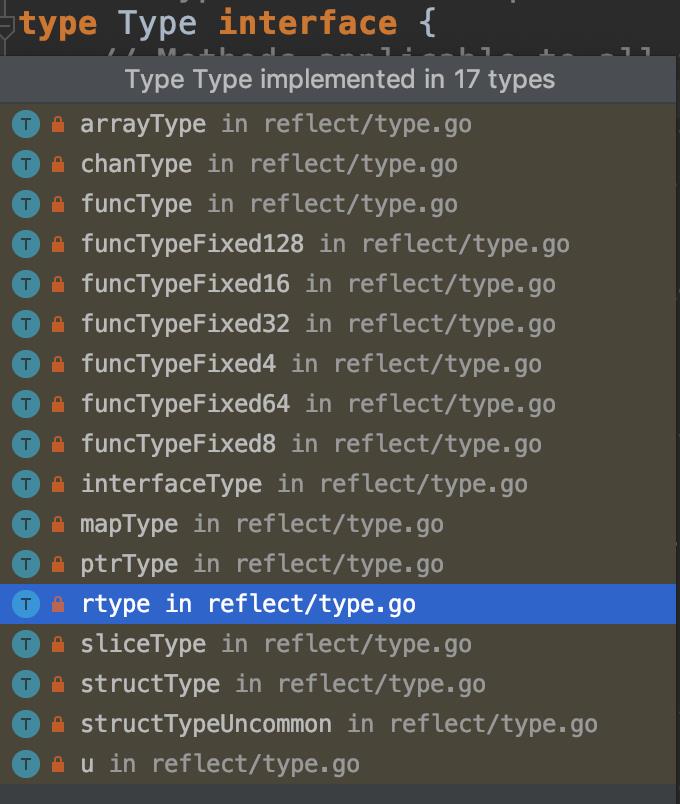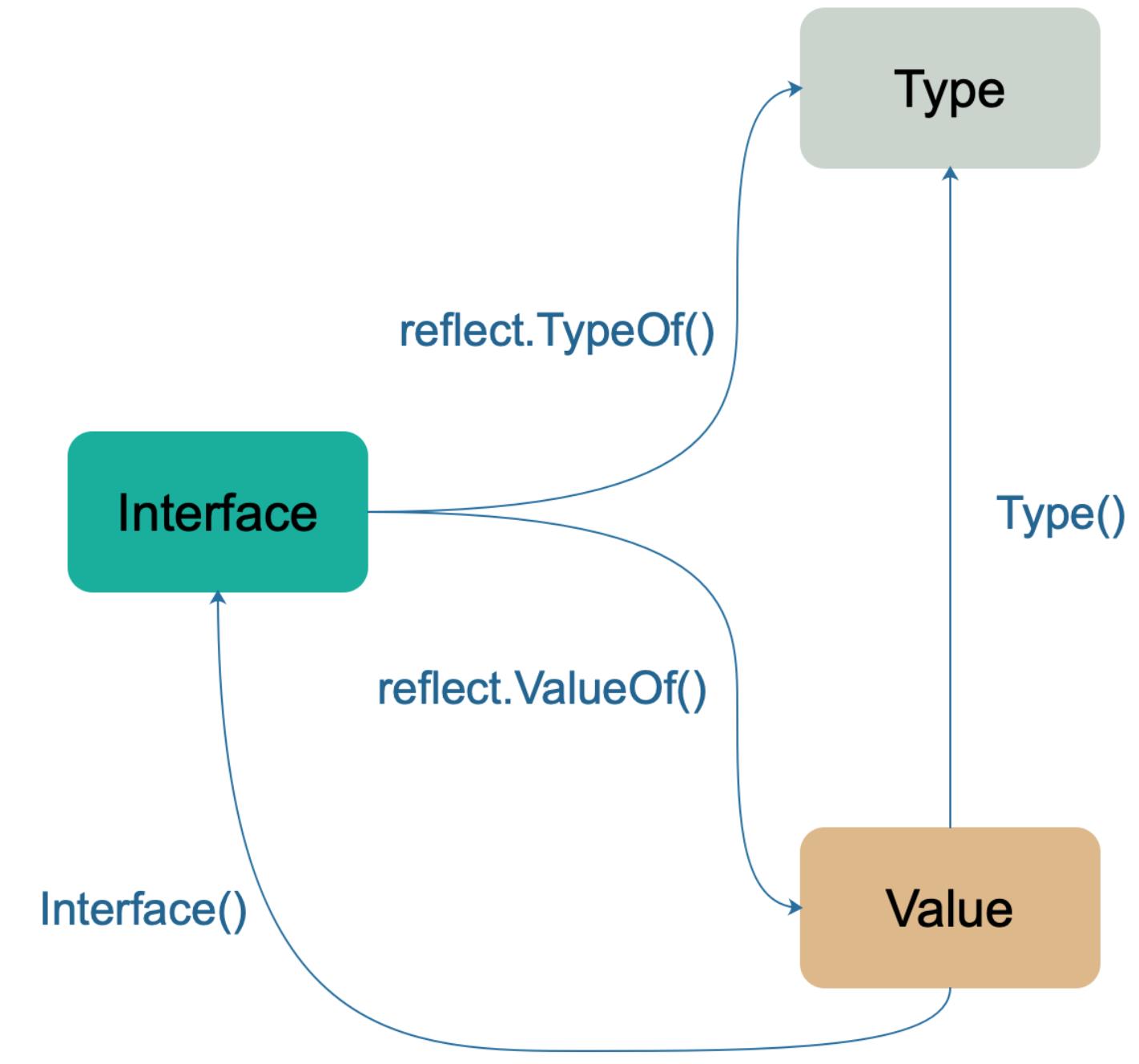golang interface 与 反射
Posted 惜暮
tags:
篇首语:本文由小常识网(cha138.com)小编为大家整理,主要介绍了golang interface 与 反射相关的知识,希望对你有一定的参考价值。
golang interface 与 反射
- golang interface 使用场景
- golang interface 数据结构
- golang interface 一些使用场景原理
- 为什么用反射
- 反射实现原理以及与interface关系
- 反射的性能损耗原因以及性能评估
base go 1.13.5
golang interface 使用场景
这里先简单描述一下 interface 的使用场景。 我们通常有两种方式使用interface,一种是带方法的interface,一种是空interface。
我们一般用带方法的interface作为一个通用的抽象。用空的interface 来作为一种泛型使用。
具体的使用姿势的形式上,一般也就是作为函数入参,返回值,属性域等等。
除了要会用、用对以外,我觉得有必要搞清楚内部原理。比如作为函数入参,返回值,值和指针接受者的函数调用等的性能损耗。
golang interface 数据结构
interface变量前面说了有两种,一种是带方法的,一种是不带方法的。编译器会自动映射成底层的两种结构:iface 和 eface。区别在于 iface 描述的接口包含方法,而 eface 则是不包含任何方法的空接口:interface。
下面看一下源码的定义: runtime/runtime2.go
type iface struct
tab *itab
data unsafe.Pointer
type eface struct
_type *_type
data unsafe.Pointer
// 描述带方法的interface的类型信息以及接口信息
type itab struct
inter *interfacetype
_type *_type
hash uint32 // copy of _type.hash. Used for type switches.
_ [4]byte
fun [1]uintptr // variable sized. fun[0]==0 means _type does not implement inter.
// 描述接口的方法信息
type interfacetype struct
typ _type
pkgpath name
mhdr []imethod
// 描述interface存储的实际对象的类型信息
type _type struct
size uintptr
ptrdata uintptr // size of memory prefix holding all pointers
hash uint32
tflag tflag
align uint8
fieldalign uint8
kind uint8
alg *typeAlg
// gcdata stores the GC type data for the garbage collector.
// If the KindGCProg bit is set in kind, gcdata is a GC program.
// Otherwise it is a ptrmask bitmap. See mbitmap.go for details.
gcdata *byte
str nameOff
ptrToThis typeOff
从eface和iface的定义可知道,interface的portal层的定义实际上是2个指针,一个类型相关的信息,一个是指向实际存储对象的数据指针。也就是16个字节。itab的fun 字段放置和接口方法对应的具体数据类型的方法地址,实现接口调用方法的动态分派,一般在每次给接口赋值发生转换时会更新此表,或者直接拿缓存的 itab。
另外,你可能会觉得奇怪,为什么 fun 数组的大小为 1,要是接口定义了多个方法可怎么办?实际上,这里存储的是第一个方法的函数指针,如果有更多的方法,在它之后的内存空间里继续存储。从汇编角度来看,通过增加地址就能获取到这些函数指针,没什么影响。顺便提一句,这些方法是按照函数名称的字典序进行排列的。
再看一下 interfacetype 类型,它描述的是接口的类型:
type interfacetype struct
typ _type
pkgpath name
mhdr []imethod
可以看到,它包装了 _type 类型,_type 实际上是描述 Go 语言中各种数据类型的结构体。我们注意到,这里还包含一个 mhdr 字段,表示接口所定义的函数列表, pkgpath 记录定义了接口的包名。
下面用一张图描述 iface 的全貌:

下面可以看一个实例:
package main
import "fmt"
func main()
x := 100
var inter interface = x
fmt.Println(inter)
g := Gopher"Go"
var c coder = g
fmt.Println(c)
type coder interface
code()
debug()
type Gopher struct
language string
func (p Gopher) code()
fmt.Printf("I am coding %s language\\n", p.language)
func (p Gopher) debug()
fmt.Printf("I am debuging %s language\\n", p.language)
通过 go tool compile -S 输出汇编代码,可以看到,main 函数里调用了两个函数:
func convT64(val uint64) (x unsafe.Pointer)
func convTstring(val string) (x unsafe.Pointer)
这里编译器可以自动识别数据的类型,并转换成对应的值。
上面的convTXXX函数定义在 runtime/iface.go 里面,这个文件里面有一段注释:
// The conv and assert functions below do very similar things.
// The convXXX functions are guaranteed by the compiler to succeed.
// The assertXXX functions may fail (either panicking or returning false,
// depending on whether they are 1-result or 2-result).
// The convXXX functions succeed on a nil input, whereas the assertXXX
// functions fail on a nil input.
下面的conv和assert函数做的事情非常类似。
编译器保证了convXXX函数的成功。
assertXXX函数可能失败(panic或返回false,这取决于它们是1-结果,还是2-结果)。
convXXX函数在nil输入时成功,而assertXXX则失败
这里列出所有的函数:
//下面的这些方法是将指定的类型转换成interface类型,但是下面的这些方法返回的仅仅是返回data指针
// 转换对象成一个 interface
func convT2E(t *_type, elem unsafe.Pointer) (e eface)
// 转换uint16成一个interface的data指针
func convT16(val uint16) (x unsafe.Pointer)
// 转换uint32成一个interface的data指针
func convT32(val uint32) (x unsafe.Pointer)
// 转换uint64成一个interface的data指针
func convT64(val uint64) (x unsafe.Pointer)
// 转换string成一个interface的data指针
func convTstring(val string) (x unsafe.Pointer)
// 转换slice成一个interface的data指针
func convTslice(val []byte) (x unsafe.Pointer)
// 转换t类型的元素到interface, 这里的t不是指针类型
func convT2Enoptr(t *_type, elem unsafe.Pointer) (e eface)
// 指定类型的到 interface 的转换
func convT2I(tab *itab, elem unsafe.Pointer) (i iface)
// 指定类型到 interface 的转换,不是指针
func convT2Inoptr(tab *itab, elem unsafe.Pointer) (i iface)
// interface到interface的转换。
func convI2I(inter *interfacetype, i iface) (r iface)
// 下面是断言调用的一些函数
func assertI2I(inter *interfacetype, i iface) (r iface)
func assertI2I2(inter *interfacetype, i iface) (r iface, b bool)
func assertE2I(inter *interfacetype, e eface) (r iface)
func assertE2I2(inter *interfacetype, e eface) (r iface, b bool)
这些函数在将指定类型转换成 interface 和 interface做类型断言时候会调用。在我当前go版本1.13.5中还做了一些优化,对于一些特定类型的,比如int等基本数字数据类型、String、slice等等,只需要做调用mallocgc 申请一片新内存,然后做赋值。但是对于具体类型准换成interface等场景,除了调用mallocgc 申请内存,还需要内存的拷贝。
具体场景看下面的内容。
golang interface 一些使用场景原理
函数参数是 interface 的成本
我们经常使用的一个场景就是函数的参数是 interface或则是一个由函数的interface。比如:
func m1(p interface)
这个时候我们传递参数,参数是一个具体的数据类型,比如是一个struct或则是一个基本类型,那么就需要将这个具体的类型转换成 interface, 这个时候是有性能损耗的。如果我们在函数内部想要获得具体的类型做类型断言,这个时候也是有性能损耗的。
具体性能损耗对比,可以参考golang type assertion and unsafe.Pointer 性能对比
interface和带方法的interface的赋值过程
赋值过程其实就是类型转换的过程,具体就是调用 conVxxxx 函数。过程也比较简单,细节可以参考源码。
动态类型与动态分发是如何实现的,动态分发什么时候进行,并且有什么样的调用成本
首先说一下动态类型是怎么实现的。对于interface来说,动态类型用 _type 来描述。对于非空interface来说,动态类型由itab 来描述。
我们看一个例子来验证对象的动态类型。
package main
import (
"fmt"
"reflect"
"unsafe"
)
type iface struct
itab, data uintptr
func main()
var a interface = nil
bi := new(int)
*bi = 10
var b interface = bi
x := 5
var c interface = (*int)(&x)
ia := *(*iface)(unsafe.Pointer(&a))
ib := *(*iface)(unsafe.Pointer(&b))
ic := *(*iface)(unsafe.Pointer(&c))
fmt.Println(ia, ib, ic)
fmt.Println(reflect.TypeOf(b) == reflect.TypeOf(c))
看看输出的结果:
0 0 17454368 824634166904 17454368 824634166896
true
对于ib和ic的类型字段指针地址是一样的,也就是说两个是同一个对象。通过调用reflect.TypeOf也能得以验证。
如何进行类型转换
通过前面的 iface 的源码可以看到,实际上它包含接口类型 interfacetype 和 实体类型 _type,这两个都是 iface 的字段 itab 的成员。也就是说生成一个 itab 同时需要接口的类型和实体的类型。
interfacetype的结构再贴一次:
type interfacetype struct
typ _type
pkgpath name
mhdr []imethod
type imethod struct
name nameOff
ityp typeOff
我们在判断一种类型是否满足某个接口时,Go 使用类型的方法集和接口所需要的方法集进行匹配,如果类型的方法集完全包含接口的方法集,则可认为该类型实现了该接口。
比如:某个类型有 m 个方法,某个接口有 n 个方法,则很容易知道这种判定的时间复杂度为 O(mn),Go 会对方法集的函数按照函数名的字典序进行排序,所以实际的时间复杂度为 O(m+n)。
实际的类型转换实现是通过调用 runtime/iface.go 里面的方法:
func convI2I(inter *interfacetype, i iface) (r iface)
将一个 interface 转换成另外一个 interface。
具体实现如下:
func convI2I(inter *interfacetype, i iface) (r iface)
tab := i.tab
if tab == nil
return
if tab.inter == inter
r.tab = tab
r.data = i.data
return
r.tab = getitab(inter, tab._type, false)
r.data = i.data
return
这里面最重要的就是 getitab 函数的源码,这里源码和细节就不说了,感兴趣可以看源码。简单说就是 getitab 函数会根据 interfacetype 和 _type 去全局的 itab 哈希表中查找,如果能找到,则直接返回;否则,会根据给定的 interfacetype 和 _type 新生成一个 itab,并插入到 itab 哈希表,这样下一次就可以直接拿到 itab。
如何进行断言,断言的成本有多高
断言的实现,实际上也是调用 runtime/iface.go 里面的 assertXXX方法,具体实现参考源码。
为什么用反射
Go 语言提供了一种机制在运行时更新变量和检查它们的值、调用它们的方法,但是在编译时并不知道这些变量的具体类型,这称为反射机制。
关于为什么使用反射,这里列出两个常用场景:
- 有时你需要编写一个函数,但是并不知道传给你的参数类型是什么,可能是没约定好;也可能是传入的类型很多,这些类型并不能统一表示。这时反射就会用的上了。
- 有时候需要根据某些条件决定调用哪个函数,比如根据用户的输入来决定。这时就需要对函数和函数的参数进行反射,在运行期间动态地执行函数。
但是注意,使用反射是有有很多缺点的。比较重要的就是:性能损耗,以及代码的安全性。
- Go语言作为一门静态语言,编码过程中,编译器能提前发现一些类型错误,但是对于反射代码是无能为力的。所以包含反射相关的代码,很可能会运行很久,才会出错,这时候经常是直接 panic,可能会造成严重的后果。
- 反射对性能影响还是比较大的,比正常代码运行速度慢一到两个数量级。所以,对于一个项目中处于运行效率关键位置的代码,尽量避免使用反射特性。
反射实现原理以及与interface关系
前面讲了,interface 是 Go 描述对象的一个非常强大的抽象。当向接口变量赋值一个实体类型的时候,接口会存储实体的类型信息,反射就是通过接口的类型信息实现的,反射建立在类型的基础上。
Go 语言在 reflect 包里定义了各种类型,实现了反射的各种函数,通过它们可以在运行时检测类型的信息、改变类型的值。
反射的Type和interface
Go是一个强类型的语言,每个类型都有一个静态类型,并且这个静态类型在编译阶段就能够确认。比如int, int[],string等等,需要注意的是,这个类型是声明时候的类型,不是底层数据类型。
比如:
type TestInt int
var i int
var j TestInt
这里i和j的存储类型虽然都是int, 但是对于Go来说,i和j却是两个不同的静态类型,也不能用于互相赋值,除非做类型转换。
理解Go的反射,就必须理解interface的结构,这两种息息相关。前面已经描述了 interface 的底层结构,这里再来复习一下:
type iface struct
tab *itab
data unsafe.Pointer
// 描述带方法的interface的类型信息以及接口信息
type itab struct
inter *interfacetype
_type *_type
hash uint32 // copy of _type.hash. Used for type switches.
_ [4]byte
fun [1]uintptr // variable sized. fun[0]==0 means _type does not implement inter.
// 描述接口的方法信息
type interfacetype struct
typ _type
pkgpath name
mhdr []imethod
// 描述interface存储的实际对象的类型信息
type _type struct
size uintptr
ptrdata uintptr // size of memory prefix holding all pointers
hash uint32
tflag tflag
align uint8
fieldalign uint8
kind uint8
alg *typeAlg
// gcdata stores the GC type data for the garbage collector.
// If the KindGCProg bit is set in kind, gcdata is a GC program.
// Otherwise it is a ptrmask bitmap. See mbitmap.go for details.
gcdata *byte
str nameOff
ptrToThis typeOff

iface 描述的是非空接口,它包含方法;与之相对的是 eface,描述的是空接口,不包含任何方法,Go 语言里有的类型都 “实现了” 空接口。
我们再看看reflect里面的基本数据类型和接口。reflect 包里定义了一个接口和一个结构体,即 reflect.Type 和 reflect.Value,它们提供很多函数来获取存储在接口里的类型信息。
reflect.Type 是一个接口,提供了很多方法老获取关于类型相关的信息,rtype 实现了 Type 接口。我们可以看下图,对于Go的其余类型,比如sliceType也默认实现了reflect.Type接口。实际上sliceType等都是组合了rtype和一个类型特有的信息。

看下 rtype 的定义:
// rtype is the common implementation of most values.
// It is embedded in other struct types.
//
// rtype must be kept in sync with ../runtime/type.go:/^type._type.
type rtype struct
size uintptr
ptrdata uintptr // number of bytes in the type that can contain pointers
hash uint32 // hash of type; avoids computation in hash tables
tflag tflag // extra type information flags
align uint8 // alignment of variable with this type
fieldAlign uint8 // alignment of struct field with this type
kind uint8 // enumeration for C
alg *typeAlg // algorithm table
gcdata *byte // garbage collection data
str nameOff // string form
ptrToThis typeOff // type for pointer to this type, may be zero
rtype 是Go里面其余类型的基础类型,会被内嵌在很多其余类型struct里面。也就是说所有的类型都会包含 rtype 这个字段,表示各种类型的公共信息;另外,不同类型包含自己的一些独特的部分。比如下面的:
// arrayType represents a fixed array type.
type arrayType struct
rtype
elem *rtype // array element type
slice *rtype // slice type
len uintptr
// chanType represents a channel type.
type chanType struct
rtype
elem *rtype // channel element type
dir uintptr // channel direction (ChanDir)
.....
funcType
ptrType
sliceType
structType
......
此外rtype必须和…/runtime/type.go里面的 _type 保持一致。这里肯定用于和interface里面的类型指针做指针类型转换的。
再来看看 reflect.Value的结构:
// reflect/value.go
type Value struct
// typ holds the type of the value represented by a Value.
typ *rtype
// Pointer-valued data or, if flagIndir is set, pointer to data.
// Valid when either flagIndir is set or typ.pointers() is true.
ptr unsafe.Pointer
// flag holds metadata about the value.
// The lowest bits are flag bits:
// - flagStickyRO: obtained via unexported not embedded field, so read-only
// - flagEmbedRO: obtained via unexported embedded field, so read-only
// - flagIndir: val holds a pointer to the data
// - flagAddr: v.CanAddr is true (implies flagIndir)
// - flagMethod: v is a method value.
// The next five bits give the Kind of the value.
// This repeats typ.Kind() except for method values.
// The remaining 23+ bits give a method number for method values.
// If flag.kind() != Func, code can assume that flagMethod is unset.
// If ifaceIndir(typ), code can assume that flagIndir is set.
flag
......
可以看到Value里面实际上是包含类型信息的,然后也包含一个指向实际value的指针。
reflect 包中提供了两个基础的关于反射的函数来获取上述的接口和结构体:
func TypeOf(i interface) Type
func ValueOf(i interface) Value
TypeOf 函数用来提取一个接口中值的类型信息。由于它的输入参数是一个空的 interface,调用此函数时,实参会先被转化为 interface类型。这样,实参的类型信息、方法集、值信息都存储到 interface 变量里了。
ValueOf 函数返回值 reflect.Value 表示 interface 里存储的实际变量,它能提供实际变量的各种信息。相关的方法常常是需要结合类型信息和值信息。例如,如果要提取一个结构体的字段信息,那就需要用到 _type (具体到这里是指 structType) 类型持有的关于结构体的字段信息、偏移信息,以及 *data 所指向的内容 —— 结构体的实际值。
这里引用老钱《快学Go语言第十五课——反射》的一张图:

reflect.TypeOf 函数解析
// TypeOf returns the reflection Type that represents the dynamic type of i.
// If i is a nil interface value, TypeOf returns nil.
func TypeOf(i interface) Type
eface := *(*emptyInterface)(unsafe.Pointer(&i))
return toType(eface.typ)
// emptyInterface is the header for an interface value.
type emptyInterface struct
typ *rtype
word unsafe.Pointer
// toType converts from a *rtype to a Type that can be returned
// to the client of package reflect. In gc, the only concern is that
// a nil *rtype must be replaced by a nil Type, but in gccgo this
// function takes care of ensuring that multiple *rtype for the same
// type are coalesced into a single Type.
func toType(t *rtype) Type
if t == nil
return nil
return t
当我们调用 reflect.TypeOf 函数时候,首先会将入参实际类型转换成 interface,然后通过非类型安全的指针转换成emptyInterface。 最后获取实际的类型对象 rtype (rtype实现了reflect.Type接口)。最后实际返回的是接口,reflect.Type, 所以可以通过调用 reflect.Type的各种接口函数获取类型信息。
reflect.ValueOf 函数解析
func ValueOf(i interface) Value
if i == nil
return Value
// TODO: Maybe allow contents of a Value to live on the stack.
// For now we make the contents always escape to the heap. It
// makes life easier in a few places (see chanrecv/mapassign
// comment below).
escapes(i)
return unpackEface(i)
func escapes(x interface)
if dummy.b
dummy.x = x
// unpackEface converts the empty interface i to a Value.
func unpackEface(i interface) Value
e := (*emptyInterface)(unsafe.Pointer(&i))
// NOTE: don't read e.word until we know whether it is really a pointer or not.
t := e.typ
if t == nil
return Value
f := flag(t.Kind())
if ifaceIndir(t)
f |= flagIndir
return Valuet, e.word, f
reflect.ValueOf 函数返回的是反射的 Value 对象。主要主干流程如下:
- 首先会调用
escapes函数确保输入对象分配在堆上; - 做非类型安全指针转换成
*emptyInterface; - 封装emptyInterface里面的 type 和 value 到
reflect.Value。
通过reflect.Value 可以读写对象。
反射的性能损耗原因以及性能评估
reflect.TypeOf 和 reflect.ValueOf 的损耗并不多,涉及到主要是 interface 的装箱/拆箱操作,或者是创建新的Value对象。
装箱拆箱带来的性能影响可以参考 golang type assertion and unsafe.Pointer 性能对比
下面测试:
- 通过反射和直接New创建对象性能;
- 通过反射获取对象设置值、通过field的name设置值、通过index设置值、原生的直接设置值的性能;
测试环境:Mac2015款,2核心,8G内存。Go1.13.5
测试代码:
package main
import (
"reflect"
"testing"
)
func BenchmarkReflect_New(b *testing.B)
var s *Student
sv := reflect.TypeOf(Student)
b.ResetTimer()
for i := 0; i < b.N; i++
sn := reflect.New(sv)
s, _ = sn.Interface().(*Student)
_ = s
func BenchmarkDirect_New(b *testing.B)
var s *Student
b.ResetTimer()
for i := 0; i < b.N; i++
s = new(Student)
_ = s
func BenchmarkReflect_Set(b *testing.B)
var s *Student
sv := reflect.TypeOf(Student)
b.ResetTimer()
for i := 0; i < b.N; i++
sn := reflect.New(sv)
s = sn.Interface().(*Student)
s.Name = "Jerry"
s.Age = 18
s.Class = "20005"
s.Score = 100
func BenchmarkReflect_SetFieldByName(b *testing.B)
sv := reflect.TypeOf(Student)
b.ResetTimer()
for i := 0; i < b.N; i++
sn := reflect.New(sv).Elem()
sn.FieldByName("Name").SetString("Jerry")
sn.FieldByName("Age").SetInt(18)
sn.FieldByName("Class").SetString("20005")
sn.FieldByName("Score").SetInt(100)
func BenchmarkReflect_SetFieldByIndex(b *testing.B)
sv := reflect.TypeOf(Student)
b.ResetTimer()
for i := 0; 以上是关于golang interface 与 反射的主要内容,如果未能解决你的问题,请参考以下文章